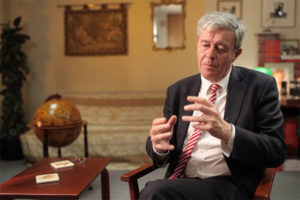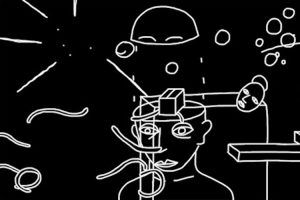Embodied Cognition
Neuroscientist Karl Friston on the place of cognition in our body and outside it, the way we perceive objects,...
The video is a part of the project British Scientists produced in collaboration between Serious Science and the British Council.
Of all the types of electron cryomicroscopy at the moment single particle electron cryomicroscopy is probably the most powerful and most successful. But in the longer term all the different applications of electronic microscopy, tomography, cellular work will fulfill that potential. The single particle methodology, you could argue, started before cryomicroscopy, before Jacques Dubochet’s method for plunge freezing samples and making cryospecimens. A couple of groups (Joachim Frank’s group, he was a student in Germany with Walter Hoppy, and then Marin Van Heel, who was a student in the Netherlands, with Erni Van Bruggen) they began working originally probably on ribosomes and other large biological structures using a method where heavy metal stains were used to embed the molecules. That avoided the need to freeze them, it avoided the radiation damage problems. They did early work at low resolution on these single particles.
In parallel there was work on helical arrangements and icosahedral virus particles at the MRC molecular biology lab here at Cambridge. So these two traditions were the early beginnings of what we could call electron microscopy structural biology. But with cryomicroscopy coming in following the Dubochet’s plunge freezing methods it became clear around about the mid 80s that this was going to be a very powerful method. We actually had a student at the MRC laboratory of molecular biology called Guy Vigors who went to a course organized by Jacques Dubochet at the European molecular biology lab in Heidelberg where they give the very first tuition in plunge freezing and electron cryomicroscopy. When he returned from this course he said: “This is the future. I’m giving up my project”. So, he stopped working on the project that we had given him. I was one of his two supervisors. He started to do single particle cryoelectron microscopy in about 1985.
And then there were a few papers from Dubochet’s group on the structure of adenovirus particles, on the structure of Semliki Forest virus particles. Other people at the European molecular biology lab published cryoEM structures of bacterial virus tails, Vigors, our student at the MRC molecular biology lab, published the structure of clathrin coats, which is the protein coat that surrounds vesicles in as part of cellular secretion mechanism. But these original cryoEM studies were limited in resolution, 40 Angstroms resolution, 50, that means low resolution, rather blobby structures. So, you’re not getting anywhere near atomic structures, where you could see the atoms of the molecules, which is, of course, the ultimate goal of structural biology is to find out the atomic structure of everything in biology.
My own involvement in this was to use cryomicroscopy to study the structure of two-dimensional crystals. We were able to find about 1990 an atomic structure for this protein bacteriorhodopsin that we worked on, which formed two-dimensional crystals. But it became clear to me and to others, and we switched around about 1995 from working on electron crystallography – that means cryo-EM of 2D crystals – to working on single particles. So, for about 20 years now we focused on why is it that single particle electron microscopy did not originally immediately give you atomic structures. It is because of technical problems with microscopes. The microscopes weren’t very good, the vacuums were bad, the brightness of the sources was bad, the detectors for measuring the images were filmed, they were not really good.
Now this field of single particle electron cryomicroscopy has become very popular even among people who knew nothing about it before. What happens now is somebody says: “You know, I’ve been trying to determine this particular protein structure for 10 years, I’ve been purifying it, I’ve been studying it, I’ve been trying to crystallize it, but I haven’t succeeded: my crystals either don’t form, or they form, but they are poorly ordered and you can’t get a structure”. And they say: “Perhaps, I should try electron cryomicroscopy”, cryoEM we call it for short. And they will go down, they’ll spend best years doing this and they will take a very tiny quantity, a few drops of their sample, put it on a grid, do the Dubochet method, where you blocked it and plunge freeze it, put it in an electron microscope, take images, which are digitized now with the new detectors, compute the structure and within a few days they’ve determined the structure they’ve spent ten years trying to do by other methods.
People who’ve been of course working in the fields for a long time knew this was coming. But it has turned out to be more successful than we thought it would be. As a result people who now have no background at all can come in and simply follow the procedure and then succeed at getting structures. It has become a kind of the gold rush in America where people will discover gold, need to go out and make their fortune. Now there are well-established people who know what they’re doing, there are people who have been learning it, but there are also newcomers who treat the whole system as a black box. They make the grids, they take the images, they process things using procedures that have been worked out and written down, and then they can see succeed. This is the goal of all of the people. It’s the goal originally of the people who were sequencing DNA to make it so simple and easy to do that people with no background can do it successfully.
Now single particle electron cryomicroscopy is very successful. There are now many structures from very large viruses (hundreds of megadaltons) down to small subcellular assemblies like the ribosome or the spliceosome; molecular machines that are underlying all the processes of life to proteins that are in membranes that transport, for example, the ATPase molecules that synthesize all the ATP right down to small enzymes or receptors that are involved in generation and the conversion of normal cells to cancer cells and so on. There are people using these tools to get analytical data on important biological processes that can affect human health, for example. I think, the single-particle electron cryomicroscopy is now adding to the power of the other methods in structural biology and in biology generally.
I should say two things about the current status of electron cryomicroscopy. One is that although many people are extremely happy with it and they just want to use it as a method. So, it’s just fitting into the spectrum of powerful methods that people use. We are not yet into a situation where we reach the end of the line. There are half a dozen different remaining barriers to progress, which if we can solve them and overcome them will make it even more powerful than it is at the moment. For example, the detectors we have, although they’re much better than film, they are only about 50% equivalent to detecting half of the electrons. The single signal-to-noise ratio can be increased by a factor of two.
There is a problem which many people are concerned about, but very few people are working on, which is that you put the beam on the specimen, bonds break, electrons are knocked out, the specimen gets charged up, the specimen is changing as you take an image, and that blurs the images. This beam-induced movement and charging is a fundamental problem, and you know, we’re working on it, a few other people are working on in it, if the images could be made to minimize that beam damage, it could be much more powerful. Other people are working on the equivalent in optical microscopy. There is something called a Zernike phase plate, which introduces a phase change in the direct beam compared to the scattered beams. We have prototypes that work and could be shown to work in principle, but they’re not yet easy to use. So, these phase plates are another way forward. Then all the electron lenses in the electron microscope are the equivalent of non-achromats. Basically, 15th century optical microscopy, before the achromatic lens was with invented which allows red and blue light to be focused at the same point.
There’s a range of topics like that, others include specimen preparation, which once those are solved single-particle electron cryomicroscopy will go from being a powerful method that many people are happy with to a real world beater. So, all of us who work in this area, we are very enthusiastic and very optimistic about it. That the future, if you like, is very bright in this area.
My own view is that once you have discovered everything in reasonable detail, so that most people are happy, you can still go on to invent things. Although there’s a limit to the number of things in biology that can be discovered, it’s a finite world, if you like. It’s a bounded universe. Beyond that you can invent anything you can think of. So, my own view is that science and structural biology, molecular biology, human biology will change from an era where most people in this lab, everyone was discovering and no one was inventing, only techniques were invented. Now it’s probably about 75 – 25, quite a lot of people are focused on inventing new therapies. Molecule antibodies is a good example. You can now learn that if you have certain types of cancer or certain virus infections, you could be treated with it, molecular antibody completely cured you. So, these are inventions. They were not naturally occurring, they were invented by humans targeting particular things. I think, there will be a change from discovery gradually one after another, and people start companies and so on. It will change from discovery to invention. And then it is limitless, you can invent any number of things in the future.

Neuroscientist Karl Friston on the place of cognition in our body and outside it, the way we perceive objects,...

Neuroscientist Klaus Linkenkaer-Hansen on the biology of mind-wandering, training one's attention, and the rol...

Scientists used 3D-printing technology to investigate the possible reasons why seahorse's tail evolved into it...